高中英语必修二第四单元教案 精华版
最新人教版高中英语必修二-Unit-4教案
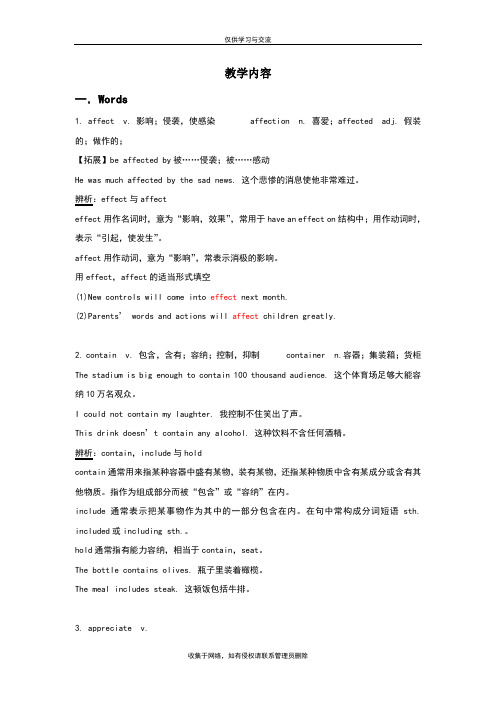
教学内容一.Words1. affect v. 影响;侵袭,使感染 affection n. 喜爱;affected adj. 假装的;做作的;【拓展】be affected by被……侵袭;被……感动He was much affected by the sad news. 这个悲惨的消息使他非常难过。
辨析:effect与affecteffect用作名词时,意为“影响,效果”,常用于have an effect on结构中;用作动词时,表示“引起,使发生”。
affect用作动词,意为“影响”,常表示消极的影响。
用effect,affect的适当形式填空(1)New controls will come into effect next month.(2)Parents’ words and actions will affect children greatly.2. contain v. 包含,含有;容纳;控制,抑制 container n.容器;集装箱;货柜The stadium is big enough to contain 100 thousand audience. 这个体育场足够大能容纳10万名观众。
I could not contain my laughter. 我控制不住笑出了声。
This drink doesn’t contain any alcohol. 这种饮料不含任何酒精。
辨析:contain,include与holdcontain通常用来指某种容器中盛有某物,装有某物,还指某种物质中含有某成分或含有其他物质。
指作为组成部分而被“包含”或“容纳”在内。
include通常表示把某事物作为其中的一部分包含在内。
在句中常构成分词短语sth. included或including sth.。
hold通常指有能力容纳,相当于contain,seat。
The bottle contains olives. 瓶子里装着橄榄。
人教版高中英语必修2第4单元教(学)案

教案设计四、教学方法1.自主学习:让学生课前预习,自主查找与本课时相关的容。
2.合作探究:小组合作从网络上查找关于野生动植物的图片和资料,帮助他们熟悉话题以便于他们在学习过程中积极参与和主动探索。
3.结合多媒体技术,采用资源式、探究式的教学方法;注重交际活动,实施开放性讨论五、教学过程Step 1 Words preview1._______far away in space or time2. ___________to go down to a lower level3. _________to do something to make a change4. ________able to control events5. _________打猎,猎取,搜寻6. __________鉴赏,感激意识到7. ____________保护…不受…伤害8._________ 回答,响应Step 2 Leading-in1. Show a shot move about Wildlife Protection 成龙呼吁保护野生动物公益广告成龙呼吁保护野生动物公益广告(英语) - 视频 - 优酷视频 - 在线观看2. Have them in pairs discuss why they are endangered and show students some pictures.Step 3 Pre-readingShow students some information about wildlife protection from the Internet and ask students to discuss the following questions in pairs,1. What is wildlife protection about?2. What endangered species do you know?3. Why are they in danger of disappearing?Step 4 Fast reading1.Read the passage quickly, and finish the main idea .Daisy took _____________to travel and talked with ____________ in her dream,本课Reading讲述的是一篇童话故事——Daisy乘坐飞毯跨越时空和藏羚羊、大象、猴子对话的神奇经历。
高中人教版英语必修2unit 4 教案
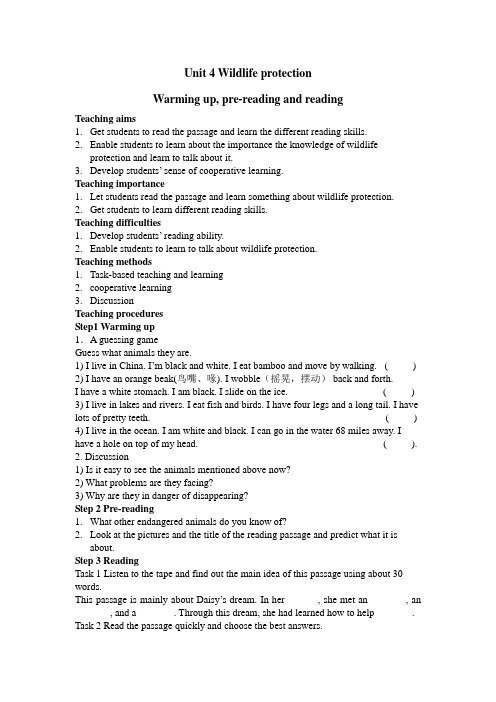
Unit 4 Wildlife protectionWarming up, pre-reading and readingTeaching aims1.Get students to read the passage and learn the different reading skills.2.Enable students to learn about the importance the knowledge of wildlifeprotection and learn to talk about it.3.Develop students’ sense of cooperative learning.Teaching importance1.Let students read the passage and learn something about wildlife protection.2.Get students to learn different reading skills.Teaching difficulties1.Develop students’ reading ability.2.Enable students to learn to talk about wildlife protection.Teaching methods1.Task-based teaching and learning2.cooperative learning3.DiscussionTeaching proceduresStep1 W arming up1.A guessing gameGuess what animals they are.1) I live in China. I’m black and white. I eat bamboo and move by walking. ( )2) I have an orange beak(鸟嘴、喙). I wobble(摇晃,摆动) back and forth.I have a white stomach. I am black. I slide on the ice. ( )3) I live in lakes and rivers. I eat fish and birds. I have four legs and a long tail. I have lots of pretty teeth. ( ) 4) I live in the ocean. I am white and black. I can go in the water 68 miles away. I have a hole on top of my head. ( ).2. Discussion1) Is it easy to see the animals mentioned above now?2) What problems are they facing?3) Why are they in danger of disappearing?Step 2 Pre-reading1.What other endangered animals do you know of?2.Look at the pictures and the title of the reading passage and predict what it isabout.Step 3 ReadingTask 1 Listen to the tape and find out the main idea of this passage using about 30 words.This passage is mainly about Daisy’s dream. In her ______, she met an _______, an _______, and a _______. Through this dream, she had learned how to help _______. Task 2 Read the passage quickly and choose the best answers.1. Why did elephants use to be an endangered species in Zimbabwe?A. Tourists hunted too many elephants.B. Farmers hunted them without mercy.C. The government encouraged farmers to hunt them.D. Their living environment was seriously polluted.2. What can be inferred from the elephant’s words, “Have you come to take my photo”?A. It thinks itself a beautiful animal.B. Elephants are friendly to human beings.C. Money from tourists went to the large tour companies.D. Now many more tourists come to take its photos rather than hunt it.3. The sentence “No rain forest, no animals and no drugs” means _________A. There was no drug in the rain forestB. Animals i n the rain forest didn’t need drugsC. Rain forest, animals and drugs were resulted in and from each otherD. Drugs were important for animals and the rain forest4. What did Daisy learn from her experience?A. Some animals were becoming endangered as a re sult of humans’ hunting.B. Wildlife should be helped and protected by us humans.C. Humans and wildlife can benefit each other in many ways.D. All of the above.Task 3 Read the passage carefully paragraph by paragraph and fill in the blanks.What can we do to help the endangered animals?Step 4 Homework1.Try to retell the story2.Preview the useful words and expressions in this passage.。
2019统编人教版高中英语必修第二册unit 4《History and traditions》全单元教案教学设计
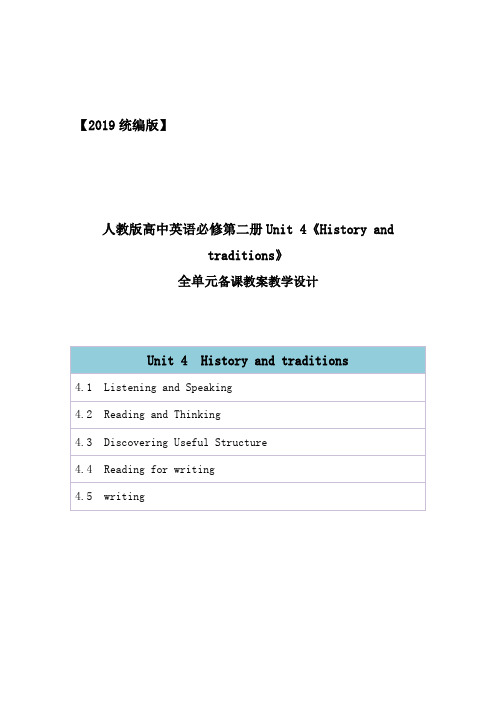
【2019统编版】人教版高中英语必修第二册Unit 4《History andtraditions》全单元备课教案教学设计Unit 4 HISTORY AND TRADITIONSListening and Speaking【教学目标】1. 掌握本课的重要词汇与句式;2. 引导学生通过课内听力训练,提高听力技巧,锻炼听力水平。
【教学重难点】1. 本课时的重要词汇与句式;2. 引导学生通过课内听力训练,提高听力技巧,锻炼听力水平。
【教学过程】Step 1 Lead inLook at the photo on Page 37, and then get the Ss to ask and answer the questions.1. What do you know about the buildings in the photo?2. What traditions of that city/country do you know about?3. Why is it important to protect historic buildings and cultural traditions?Then have some Ss share their views on the questions.Step 2 Share views on historic sites1. Before listening, get the Ss to look at some photos of Qufu in Activity 1 on Page 38. And ask “What can you say about these places?”Get the Ss to discuss in groups, and then ask several volunteers to share their views with the class.2. Listen to a conversation between a British tourist and a Chinese student inFinally check the answers with the class.3. Listen again and decide whether these statements are true (T), false (F), or not mentioned (NM).(1) Listen and judge, and check the answers.1) Confucius said that learning without understanding leads to confusion.2) Xiao Kong is doing a research project on Confucius philosophy.3) As one of Confucius’ descendants, Xiao Kong’s name is recorded in the family tree.4) Dacheng Hall is the tallest building in Qufu.(2) Then go through the question as bellow, and choose the right answer.·Why do you think William said his hometown was similar to Qufu?A. There are famous halls in his hometown.B. There are no tall buildings in his hometown.C. Both places have a famous person who was born there.D. His hometown doesn’t allow other buildings to be more noticeable than the historic buildings.4. Activity 4(1) At first, go through the Understand idioms with the Ss.An idiom is an expression which means something different from the meaning of the individual words. Some idioms present an idea or paint a picture that gives a hint as to the meaning. Other idioms can only be understood from the context in which they appear.(2) Write down the English idioms that are used in the conversation. Explain their meanings and think about some Chinese equivalents.5. Discuss the questions in groups, and then get some Ss to share their answers.(1) What do you know about Confucius’ ideas on education? Think of two or three examples. What else do you know about Confucius and his philosophy?(2) Think about a historic site that you have visited, and give an introduction to its history and importance.Step 3 Pronunciation1. Read this part of the poem “If-” written by British poet Rudyard Kipling.Notice the linking sounds. Then mark the linking sounds after the modelIf you can make one heap of all your winningsAnd risk it on one turn of pitch-and-toss,And lose, and start again at your beginningsAnd never breathe a word about your loss;If you can force your heart and nerve and sinewTo serve your turn long after they are gone,And so hold on when there is nothing in youExcept the Will which says to them: "Hold on!"2. Repeat the poem after the recording.Step 4 Homework课后练习Unit 4 HISTORY AND TRADITIONSReading and Thinking【教学目标】1. 理解并熟练掌握本课的重要词汇与句式;2. 引导学生通过课内阅读,了解英国的历史,全面培养学生的阅读能力和技巧。
高中英语必修二第四单元教案
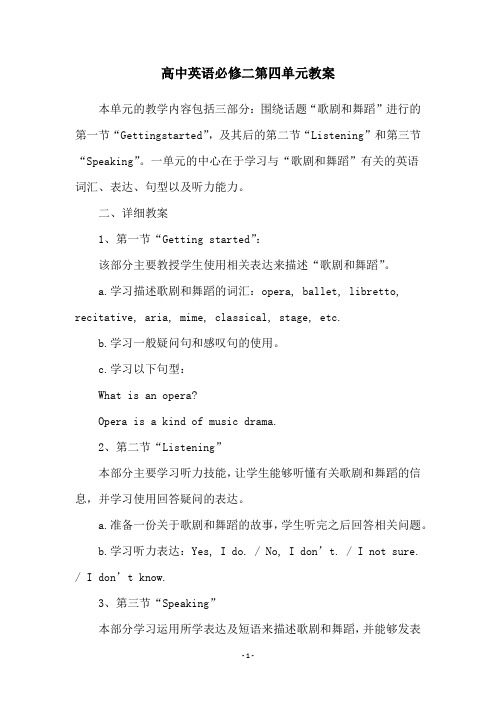
高中英语必修二第四单元教案本单元的教学内容包括三部分:围绕话题“歌剧和舞蹈”进行的第一节“Gettingstarted”,及其后的第二节“Listening”和第三节“Speaking”。
一单元的中心在于学习与“歌剧和舞蹈”有关的英语词汇、表达、句型以及听力能力。
二、详细教案1、第一节“Getting started”:该部分主要教授学生使用相关表达来描述“歌剧和舞蹈”。
a.学习描述歌剧和舞蹈的词汇:opera, ballet, libretto, recitative, aria, mime, classical, stage, etc.b.学习一般疑问句和感叹句的使用。
c.学习以下句型:What is an opera?Opera is a kind of music drama.2、第二节“Listening”本部分主要学习听力技能,让学生能够听懂有关歌剧和舞蹈的信息,并学习使用回答疑问的表达。
a.准备一份关于歌剧和舞蹈的故事,学生听完之后回答相关问题。
b.学习听力表达:Yes, I do. / No, I don’t. / I not sure. / I don’t know.3、第三节“Speaking”本部分学习运用所学表达及短语来描述歌剧和舞蹈,并能够发表看法。
a.学习一般现在时、一般过去时和现在进行时的使用。
b.学习使用以下句式:I think/believe/find/consider/feel thatc.学生可以自由发言,鼓励他们分享他们的看法和想法。
三、总结英语高中必修二第四单元的教学内容包括掌握有关“歌剧和舞蹈”的词汇、表达、句型以及听力能力,主要是结合课本原文、对话内容及语言材料,培养学生在英语听说读写方面的能力,让学生掌握有关表达及短语,以便能够正确表达自己的观点及想法。
在教学过程中,要注重学生的参与感,使课堂气氛活跃起来,以达到教学的最佳效果。
高中英语必修二第四单元教案 精华版

必修二Unit 4教案一.复习旧知灭绝动物大海牛于1768年灭绝;渡渡鸟于1681年灭绝;恐鸟于1800年左右灭绝;大海雀于1844年灭绝;开普(好望角)狮于1865年灭绝(生活最南端、最大的狮子亚种);阿特拉斯棕熊于1870年灭绝(唯一产于非洲的棕熊和熊类);南极狼于1875年灭绝(生活在地球最南端的犬科);美国缅因洲海鼬于1880年灭绝;……于20世纪90年代灭绝(区域性灭绝);亚欧水貂于1997年左右灭绝.据世界《红皮书》统计,20世纪有110个种和亚种的哺乳动物以及139种和亚种的鸟类在地球上消失了。
目前,世界上已有593种鸟、400多种兽、209种两栖爬行动物和20000多种高等植物濒于灭绝。
米长天蛾人(Mothman)是一种不明的奇异生物,又名黑天使,惟一的克星是上帝之网。
可以隐形,此时只有同伴相互可见,雌体较雄体强壮,每一具雌体都是雄体的启蒙者。
二.新课讲解1.As a result / as a result of区别as a result 作为状语来用,强调结果。
后面一般用逗号隔开。
as a result of + 名词(短语)/代词强调原因,意义相当于because of .Eg: He worked hard at his study. As a result, he passed the exam easily.As a result of his hard work, he passed the exam easily.2. Die outdie from 一般指除了疾病、情感、饥寒以外的原因而造成的死亡,指死于外因die of(内部因素)情感、疾病、饥寒死因die for为……而死,为……而献身,表示因事业或目的而死。
die out ①种类灭绝Elephants would die out soon if men were allowed to shoot.②逐渐消失Many old customs are dying out.③渐渐变小The fire died out in the enddie away 光、声音慢慢消失,风停下来He died from smoking/drinking……He hid behind the door until the footsteps had died away3. Reservevt. 1). 储备,保存;保留[(+for)]These seats are reserved for special guests. 这些座位是为特别的来宾保留的。
人教版高中英语必修二unit4学习教案

人教版高中英语必修二unit4学习教案一、教学内容二、教学目标1. 学生能够理解并掌握阅读材料中的生词和短语,如:oxygen, generate, climax等。
2. 学生能够运用一般现在时和一般过去时描述云的形成过程及特点。
3. 学生能够运用所学知识,进行有关天气和自然现象的讨论。
三、教学难点与重点1. 教学难点:一般现在时和一般过去时的运用,以及使用“It”作为形式主语的句子结构。
2. 教学重点:云的形成过程、特点以及与之相关的词汇和表达。
四、教具与学具准备1. 教师准备:PPT、黑板、粉笔、阅读材料。
2. 学生准备:课本、笔记本、字典。
五、教学过程1. 导入:通过展示一组有关天气和云的照片,引导学生讨论天气和云的特点。
2. 阅读与思考:学生阅读“A Day in the Clouds”一文,并完成相关练习,教师进行讲解。
3. 例题讲解:讲解一般现在时和一般过去时的运用,以及使用“It”作为形式主语的句子结构。
4. 随堂练习:学生完成Discovering Useful Structures部分的相关练习,教师进行点评。
5. 小组讨论:学生分组讨论,运用所学知识描述云的形成过程及特点。
六、板书设计1. Unit 4 A Day in the Clouds2. 词汇:oxygen, generate, climax等3. 句子结构:一般现在时、一般过去时,使用“It”作为形式主语七、作业设计1. 作业题目:根据课堂所学,写一篇关于云的形成过程及特点的短文。
2. 答案要求:使用一般现在时和一般过去时,不少于100词。
八、课后反思及拓展延伸1. 教师反思:关注学生在课堂上的参与程度,调整教学方法和节奏,以提高教学效果。
2. 拓展延伸:鼓励学生关注天气变化,观察云的形态,提高英语实际应用能力。
重点和难点解析1. 教学难点:一般现在时和一般过去时的运用,以及使用“It”作为形式主语的句子结构。
2. 例题讲解:讲解一般现在时和一般过去时的运用,以及使用“It”作为形式主语的句子结构。
2019新人教高中英语必修二Unit4 History and Traditions整单元完整教案

2019新人教高中英语必修二Unit 4 History and Traditions整单元完整教案Unit 4 Listening and Speaking公开课教案Teaching aims:1.Enable students to get familiar with the vocabulary of“Confucius,Temple ofConfucius,Confucius’ descendants,Confucius’ educational thoughts”.2.Guide students to understand some English idioms and their related culturalallusions.3.Help students to talk about Confucius’ ideas on education and introduce thehistory and importance of a historic site.Teaching key and difficult points:1.To help students to get familiar with the vocabulary of“Confucius,Temple ofConfucius,Confucius’ descendants,Confucius’ educational thoughts”.2.To enable students to understand English idioms and the related cultural allusions.3.To lead students to talk about Confucius’ educational thoughts.Teaching procedures:StepⅠLead-inLook at the Opening Page and have a discussion.1.How do you understand the quote“A people without the knowledge of their pasthistory, origin and culture is like a tree without roots”by Marcus Garvey?2.Why is it important to protect historic buildings and cultural traditions? Suggested answers:1.In this quote, Garvey is emphasizing the importance of knowledge about thehistory of your country and people.He uses“people”in the countable form to refer to all the persons who live in a particular place or belong to a particular country,race,or other groups. In Garvey’s case, race is especially important.A tree is a good metaphor for a group of people.For example, we talk about“family trees”,which detail our relatives across time.A tree without roots would easily fall down and die.The roots also feed the tree.The roots of a treecannot usually be seen, but they often spread deep and wide. In this way, a people’s history also has deep roots that spread far and wide.If people do not know about their history, they will not learn from the past and will not be able to develop and progress well into the future.2. It is important to protect historic buildings and cultural traditions because theyare a record of our shared history and tell us a lot about who we are as a country and people.StepⅠListeningActivity 1 Warming upLook at some photos of Qufu.What can you say about these places?Temple of ConfuciusKong FamilyMansion Cemetery of Confucius Suggested answers:Activity 1 1.Temple of Confucius:The most famous and largest temple honoring the greatsage.It is also a UNESCO World Heritage Site.It covers 16,000 square meters and has 460 rooms.The main part consists of nine courtyards with several gates.Dacheng Hall stands at the centre and is the principal place for offering sacrifices to Confucius.2.Kong Family Mansion:Located to the east of the Temple of Confucius,this was thehistorical home of the descendants of Confucius from where they managed sites and ceremonies in Qufu.Today it is a museum.3.Cemetery of Confucius:This is where Confucius and his descendants areburied.There are more than 10,000 of them,buried here over 2,000 years.The cemetery has had many renovations and extensions in its history.Activity 2 PredictionPredict what the listening text is about by looking at Activity 2 on page 38.Suggested answer:The listening text is probably about the introduction of a great educator—Confucius. Activity 3First listeningListen to a conversation between a British tourist and a Chinese student in Qufu,and then write down what they say about Confucius.(红色为学生作答)Name Fact/Opinion about ConfuciusWilliam 1.Confucius is one of his favorite philosophers.2.He was a wise man.3.He lived over 2,500 years ago.Xiao Kong 1.Confucius has over 3 million descendants.2.He was a great educator and had many ideas about education.3.He was one of the greatest minds in history.Activity 4Second listening1.Listen again and decide whether these statements are true(T),false(F),or notmentioned (NM).(1)Confucius said that learning without understanding leads to confusion.()(2)Xiao Kong is doing a research project on Confucius philosophy.()(3)As one of Confucius’ descendants,Xiao Kong’s name is recorded in the familytree.()(4)Dacheng Hall is the tallest building in Qufu.()2.Answer the question:Why do you think William said his hometown was similar toQufu?A.There are famous halls in his hometown.B.There are no tall buildings in his hometown.C.Both places have a famous person who was born there.D.His hometown doesn’t allow other buildings to be more noticeable than thehistoric buildings.Suggested answers:1.(1)F(2)F(3)NM(4)T2.DActivity 5Third listeningWrite down the English idioms that are used in the conversation.Explain their meanings and think about some Chinese equivalents.(红色为学生作答部分)English idiom Meaning Chinese equivalentAchilles’ heel something that is someone’s weakness弱点;要害pull one’s leg to joke with someone戏弄fish out of water someone who feels uncomfortable becausethey are in an unfamiliar place如芒在背StepⅠSpeakingActivity 1Draw a mind map to sort out the information about Confucius in this class and list some examples about his ideas on education.Suggested answer:Activity 2Think about a historic site that you have visited,work in groups and give an introduction to its history and importance.Suggested answer:I visited the Mogao Caves with my family recently.They are famous for their amazingpaintings and statues.They were constructed over many dynasties and are an important record of tradition and belief in China during that time.StepⅣHomework1.Share what you have learned in this class with your friends.2.Find more well-known English idioms and proverbs.Unit 4 Reading and Thinking公开课教案Teaching aims:1.Enable students to master how to read a map and know what the map shows and what the symbols mean.2.Guide students to identify the language features and the structure of the text.3.Help students to understand the significance of learning history for understanding the social and cultural situation of a country.Teaching key points:1.Lead students to apply different approaches of discourse analysis to deepen the understanding of the text and language use.2.Help students to explore and understand the basic information about the history and traditions of the UK.3.Master the structural, stylistic, and linguistic features of the exposition and the text.Teaching difficult points:1.Enable students to identify the language features and the structure of the text.2.Lead students to use critical thinking and talk about opinions and views about the UK.Teaching procedures:StepⅠLead-inAsk students to look at the map on page 40 of the textbook and discuss the following questions in pairs.1.What type of map is it?2.How many parts can you see that make up the UK?Suggested answers:1.It’s an administrative zoning map of the UK.2.There are four different countries that make up the UK.Step Ⅰ PredictionLook at the title and the map and guess what the text is about.(红色部分学生作答)Part Ⅰ Skimming for informationActivity 1Read the text quickly and then write down the main idea of each part.⇓⇓Activity 2Read the text again and then answer the questions.1.What are the four countries of the United Kingdom?Which two were the first to be joined together?2.What are two chief advantages of studying the history of a country?Suggested answers:Activity 1Part 1(Paras.1—2):The origin of the name of the UK.Part 2(Para.3):The similarities and differences of the four countries.Part 3(Paras.4—5):The history,traditions and culture of the United Kingdom.Activity 21.The four countries of the United Kingdom are England,Wales,Scotland and Northern Ireland.England and Wales were the first two to be joined together.2.Two chief advantages of studying the history of a country are to help youunderstand more about the country and its traditions and to make visiting it moreenjoyable.StepⅠ Scanning for details(红色部分学生作答)Activity 1Read the text again and sort out the information according to the timeline.When?What happened?What changed?1st century Romans arrived Towns and roads5th century Anglo-Saxons came Language and the way houses were built8th century Vikings came Vocabulary and the names of locations across the UK11th century Normans conqueredEngland after theBattle of HastingsCastles built,the legal system changed,and new wordsfrom French introduced16th century Wales was joined to the Kingdom of England18th century Scotland was joined toEngland and Wales“The Kingdom of Great Britain” formed19th century Ireland was added“The United Kingdom of Great Britain and Ireland”formed20th century The southern part ofIreland broke awayThe name changed to“the United Kingdom of GreatBritain and Northern Ireland”Activity 2Complete the conversation about the UK using the phrases in their correct forms.Activity 3Draw a mind map to summarize the useful expressions in the conversation and act it out.Suggested answers:StepⅠ Reading for SummaryActivity 1Read the text once again and fill in the blanks.19th century,the Kingdom of Ireland was added to create the United Kingdom of Great Britain and Ireland.Finally,the southern part of Ireland (3)(break) away from the UK,which resulted in the full name we have today.However,most people just use the (4)(shorten) name:the UK.The four countries (5) belong to the United Kingdom work together in some areas.There were four groups of invaders and the last group were the Normans.They had castles (6)(build) all around England and made changes (7)the legal system.Studying the history of the country will make your visit much more(8)(enjoy).The capital city London is (9)ancient port city that hasa history (10)(date) back to Roman times.Suggested answers:(1)what(2)was joined(3)broke(4)shortened(5)that/which(6)built (7)to(8)enjoyable(9)an(10)datingStepⅠ DiscussionDiscuss the following questions in pairs.1.Why is it important to study the history and culture of a country before visiting it?2.What important things should visitors know about before they come to China?Suggested answers:1.Studying a country’s history and culture before visiting it is important because it will help you understand the place better and have a more enjoyable experience.2.Visitors to China should know something about the history of the country and about the cultural traditions of the area being visited,such as the food eaten,or the festivals celebrated there.StepⅠ Homework1.Recite the summary of the passage and share the knowledge with others.2.Do some research on Chinese history,traditions and culture and make a report.Unit4 Discover Useful Structures公开课教案Teaching aims:1.Enable students to identify the past participle and explore the functions of the past participle as the object complement and the attribute.2.Guide students to sum up the usage and the functions of the past participle as the object complement and attribute;3.Help students to use the past participle to express feelings and describe situations.Teaching key and difficult points:1.Lead students to understand the functions of the past participle as the object complement and the attribute in enriching the content of sentences, describing the characteristics of things and supplementing information.2.Enlighten students to use the past participle to express feelings and describe situations.3.How to use the past participle to express feelings and describe situations properly.StepⅠLead-inLook at some pictures and appreciate the past participle by answering the functions of it.1.a broken vase2.an injured player3.a bridge built in 19374.make themselves heardSuggested answers:1.作定语2.作定语3.作定语4.作宾语补足语Step Ⅰ Master the usage of the past participle as the attribute and the object complement.Activity 1 Find and underline the past participles in the sentences below.What function do the past participles have?Answer the questions below.1.Most people just use the shortened name:“the United Kingdom” or “the UK”.2.They use the same flag,known as the Union Jack,as well as share the same currency and military defence.3.They had castles built all around England,and made changes to the legal system.小结:shortened在句1中位置在名词,known as 在句2中位置在名词。
(英语教案)英语必修二unit4教案
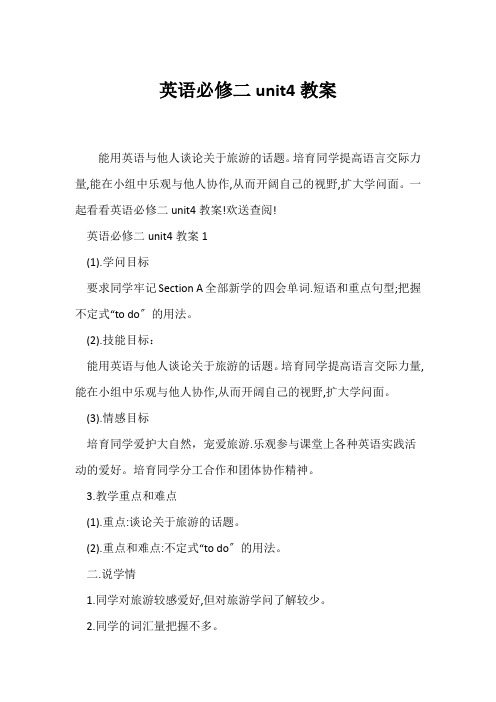
英语必修二unit4教案能用英语与他人谈论关于旅游的话题。
培育同学提高语言交际力量,能在小组中乐观与他人协作,从而开阔自己的视野,扩大学问面。
一起看看英语必修二unit4教案!欢送查阅!英语必修二unit4教案1(1).学问目标要求同学牢记Section A全部新学的四会单词.短语和重点句型;把握不定式“to do〞的用法。
(2).技能目标:能用英语与他人谈论关于旅游的话题。
培育同学提高语言交际力量,能在小组中乐观与他人协作,从而开阔自己的视野,扩大学问面。
(3).情感目标培育同学爱护大自然,宠爱旅游.乐观参与课堂上各种英语实践活动的爱好。
培育同学分工合作和团体协作精神。
3.教学重点和难点(1).重点:谈论关于旅游的话题。
(2).重点和难点:不定式“to do〞的用法。
二.说学情1.同学对旅游较感爱好,但对旅游学问了解较少。
2.同学的词汇量把握不多。
3. 同学平常较少用英语与他人交谈并表达信息.。
三.说教法学法依据课程改革的要求,遵循“老师由主演化导演,同学由配角变主角〞的角色转换,接受把课堂交给同学的教学理论,我运用自由争辩.分组工作.结对练习.问答练习等方法,借助多媒体、录音机,图片等教学手段,设置特定的语言环境,使同学在轻松开心的气氛中理解.运用英语。
四.说教学程序我设计了以下的步骤来训练同学的听.说.读.写的力量,尤其是他们“说〞的力量。
(一)温故知新(1).请两位同学用上节课重点句型号,分别复述Unit 5 Topic3 SectionD 1a(2).老师与同学之间进行问答对话,让同学谈论关于他们最宠爱的旅游方式。
设计意图:稳固上节课学过的学问,为学习新课铺垫。
(二)情景导入用多媒体呈现一些关于旅游和交通的图片,来引起同学的爱好,并由此教学本节课的新单词,如:field ,trip ,cycle ,vehicle ,airline等。
设计意图:通过用多媒体呈现同学生疏的交通工具图片,激发同学的学习爱好,轻松把握新单词,顺当带入新课。
高一英语必修2第四单元教案

Unit 4 Wildlife Protection●Teaching Aims: (教学目标)Knowledge aims: (学问目标)a. help Ss to understand and master the words and expressionsb. Let the students know some basic information about the endangered animals andwildlife situation and protection.Ability aims: (实力目标)a. Encourage Ss to think and express their attitude towards the wildlife and thewildlife protection.b. Enhance Ss’ reading ability and develop Ss’ ability and skills of guessing wordsand reading comprehension.Emotional aims: (情感目标)a. Help Ss understand the importance of the wildlife protection and make them bemore active in the helping wildlife.b. Develop Ss’ sense of cooperative learning.●Teaching Key Points:(教学重点)a. To train the reading comprehension to the whole passageb. To improve Ss’ ability of listening, speaking, reading and writing.●Teaching Difficult Points: (教学难点)a. Enhance the students reading skills in the passage.●Teaching Materials: (教学材料)blackboard, books, and other normal teaching tools.●Teaching methods:(教学方法)Co-operative learningActivity-based teaching (individual work; group work; class work)Students-centered approach & Task-based teaching and learning●Teaching Procedures: (教学过程)Step 1: Review the new words and expressions.(2m)Step2 Lead-in (3m)Task: Group WorkShow some familiar pictures to draw the students’ attentions to the wildlife(fox, elephant, kangaroo, tiger, panda, bear, whales, golden monkey, Asian elephant, famingo and so on), and bring the question: Do you think what wildlife are? Encourage Ss to discuss with each other and then solve the question together.Step3: Warming up & pre-reading (6m)Task 1:Show the pictures again and ask Ss to guess which animals are in danger. If the student answer is right, give the beautiful pictures as reward. And then make the Ss have a talking:Why are they endangered?Suggested answers:(1) People killed the endangered animals simply to satisfy their desire to eat.(2) People kill animals for their fur, which can be made into beautiful and expensivefur coat.(3) People didn’t protect the nature. They destroyed it willfully.Task 2:(1) Who is the most dangerous enemy of animals?suggested answer: Human beings.(2) What relationship between people and wildlife should be?suggested answer Wildlife is human friends. They can keep the balance ofnature and make the whole world colorful. To protect wildlife is to protectourselvesStep 4: Listening Task (6m)Play the tape of the reading passage, and ask Ss to finish the following questions, and tick all the mentioned words out while listening:1. What places did Daisy go?A. Tibet ChinaB. rain forestC. WWFD. Zimbabwe2. How many animals did she meet? What are they?A. antelopeB. elephantC. monkeyD. mosquitoes3. What helps Daisy meet the wildlife?A. By a flying chairB. By a flying broom(扫把)C. By a flying carpetSuggested answers: 1. ABD 2. ABC 3. CStep 5 reading (26m)Task1 Fast reading :Suggested answers:antelope,Tibet ;elephant,Zimbabwe ;monkey,Rainforest 。
高一英语必修2 unit 4 讲课教案
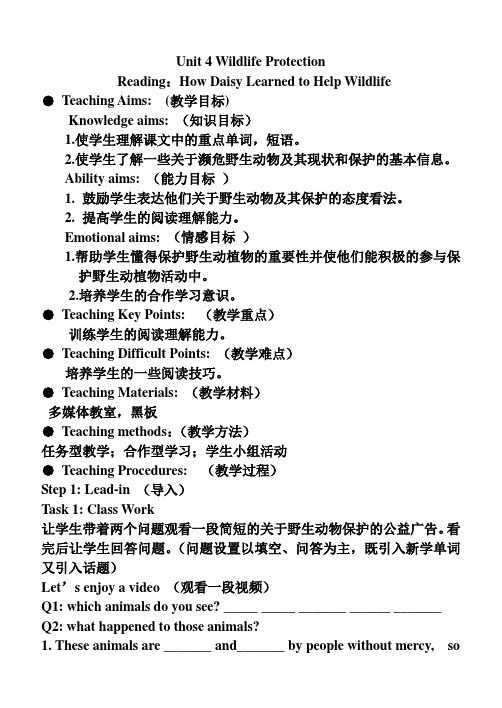
Unit 4 Wildlife ProtectionReading:How Daisy Learned to Help Wildlife●T eaching Aims: (教学目标)Knowledge aims: (知识目标)1.使学生理解课文中的重点单词,短语。
2.使学生了解一些关于濒危野生动物及其现状和保护的基本信息。
Ability aims: (能力目标)1.鼓励学生表达他们关于野生动物及其保护的态度看法。
2.提高学生的阅读理解能力。
Emotional aims: (情感目标)1.帮助学生懂得保护野生动植物的重要性并使他们能积极的参与保护野生动植物活动中。
2.培养学生的合作学习意识。
●T eaching Key Points: (教学重点)训练学生的阅读理解能力。
●T eaching Difficult Points: (教学难点)培养学生的一些阅读技巧。
●T eaching Materials: (教学材料)多媒体教室,黑板●T eaching methods:(教学方法)任务型教学;合作型学习;学生小组活动●T eaching Procedures: (教学过程)Step 1: Lead-in (导入)Task 1: Class Work让学生带着两个问题观看一段简短的关于野生动物保护的公益广告。
看完后让学生回答问题。
(问题设置以填空、问答为主,既引入新学单词又引入话题)Let’s enjoy a video (观看一段视频)Q1: which animals do you see? _____ _____ _______ ______ _______Q2: what happened to those animals?1. These animals are _______ and_______ by people without mercy, sothey are in danger of ____________now.2. Just as Chenglong said, “ When the buying stops, the killing can too! ”Step 2: Reading (阅读)I: Fast Reading (略读)Task 1:(速度文章获取文章大意)题型设置:选择题Task1 : Fast reading :Read the passage quickly and silently. try to find out the main idea. The passage is mainly about ______.A. some protection of wildlifeB. a journey of a flying carpetC. Daisy’s wonderful experience with some animalsTask 2:填表格Read the passage again and fill in the tableII: Careful Reading (详读)把文章分成三大部分,各部任务设置以选择,判断正误,回答问题,填空等为主。
高中英语人教版必修二Unit4 Learning about Language教案设计

Unit4 Learning about Language教案设计高中英语人教版必修二的基本结构。
”复习“一般现在进行时1. 教学目标复习“现在进行时被动语态”的概念,结构,运用及其注意点。
2.动词的一直性be掌握“一般现在进行时”中人称和 1.教学重点掌握将“一般现在进行时(主动语态)”转变为“现在进行时被动语态”。
2.教学难点特殊疑问------一般疑问句掌握“现在进行时被动语态”的各句式之间的转换,肯定句---否定句3.句。
回顾旧知。
Step 1:2 Unit 3重要词汇和词组一、听写必修二、练习现在完成时被动语态的习题(The Present Continuous Passive Voice) Step 2:讲解“现在进行时被动语态”一、找出下列句子中的“时态语态”结构。
1. We are being killed for the wool beneath our stomachs.2. Our fur is being used to make sweaters for people like you.3. I wonder what is being done to help you.教学过程4. So good things are being done here to save local wildlife.概括:语态,表示表示因为are/is being 时态,being killed/used/done(时态,语态)所以are/is being killed/used/done表示现在进行时的被动语态被动现在进行Key:The Present Continuous Passive Voice二、主语是动作的承受者。
/意义:表示“某人事此时此刻正在被……”, 1. am/is/are (not) + being + V-2.基本形式(肯定句形式):过去分词1 / 6高中英语人教版必修二Unit4 Learning about Language教案设计2 / 6高中英语人教版必修二Unit4 Learning about Language教案设计高中英语人教版必修二Unit4 Learning about Language教案设计4 / 6高中英语人教版必修二Unit4 Learning about Language教案设计5 / 6高中英语人教版必修二Unit4 Learning about Language教案设计6 / 6。
高中英语人教版必修二Unit4 教案

三、学习者特征分析(学生对预备知识的掌握了解情况,学生在新课的学习方法的掌握情况,如何设计预习)
素质教育的本质是要培养能够独立学习、自我创新的能力型人才,而新的人教版教材特别注意教材在这方面的设计。我们应该努力朝向让学生成人、成才、成功的方向上引导学生循着科学家的足迹,感受科学探究的一般程序,并从中领悟到科学方法和科学家之所以成功所必须具备的能力。
五、教学过程(设计本课的学习环节,明确各环节的子目标)
教师活动
预设学生活动
设计意图
Show some pictures of some endangered species
Discuss and take notes.
Import topic.
Brainstorming
what’s the name of animals on the pictures?
Talk about these endangered animals in English ?
Discuss a problem.
Interact with students to learn English.
1.What is wildlife protection about?
2. What endangered species do you know of?
Discuss:interested in wildlife problems that are happening far these questions.
Let students love animals.
人教版高一英语必修二Unit4 Reading 课程教学设计
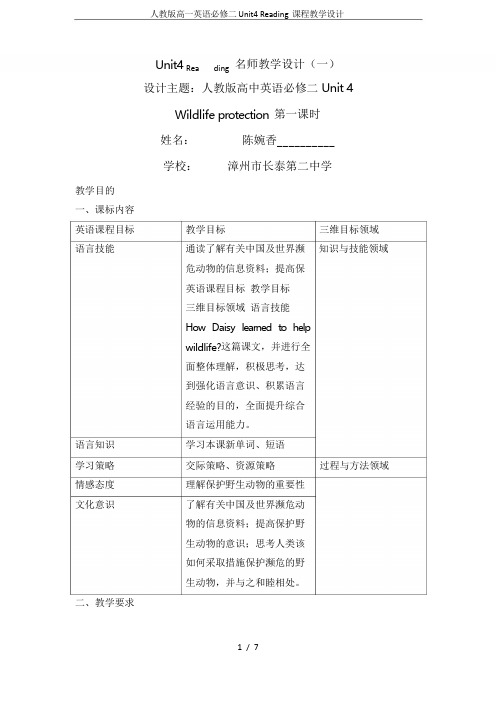
教学目的一、课标内容英语课程目标语言技能语言知识Unit4Rea ding名师教学设计(一)设计主题:人教版高中英语必修二Unit4Wildlife protection第一课时姓名:陈婉香__________学校:漳州市长泰第二中学教学目标三维目标领域通读了解有关中国及世界濒知识与技能领域危动物的信息资料;提高保英语课程目标教学目标三维目标领域语言技能How Daisy learned t o helpwildlife?这篇课文,并进行全面整体理解,积极思考,达到强化语言意识、积累语言经验的目的,全面提升综合语言运用能力。
学习本课新单词、短语学习策略情感态度文化意识二、教学要求交际策略、资源策略理解保护野生动物的重要性了解有关中国及世界濒危动物的信息资料;提高保护野生动物的意识;思考人类该如何采取措施保护濒危的野生动物,并与之和睦相处。
过程与方法领域基本要求 1.了解保护野生动物的一些现状;对保护野生动物的重要性进行思考;理解人与自然和谐相处的重要性。
2.初步掌握本单元出现的词汇用法。
发展要求 1.思考野生动物生存现状的变化对大自然的影响;学会用英语讲述人类该如何去保护野生动物的话题。
2.通过进行语言运用能力的训练培养自己分析日常生活中保护野生动物方面出现的问题,并讨论可采取的措施。
三、学情分析(一)学生的知识水平一方面,学生进入高一英语的学习,逐渐适应高中英语的学习方式,积累了一定的词汇量,并可以用英语简单表达自己的一些思想。
另一方面,学生在生物学科中已经学了关于生态环境的一些知识,对野生动物的生存状态和产生原因有一定的了解,这都为本节课的进行奠定了良好的基础。
(二)学生的情感态度价值观学生处在好动、善良、富有同情心的青少年时期,对动物具有比较强烈的兴趣,也可能对濒危的野生动物的遭遇给予极大的同情,并会热心地想办法来解决这个问题。
但同时,学生可能也会有意无意地伤害一些动物,通过这堂课的学习,可以让学生意识到这种行为的错误。
英语必修二unit4教案

英语必修二unit4教案(实用版)编制人:__________________审核人:__________________审批人:__________________编制单位:__________________编制时间:____年____月____日序言下载提示:该文档是本店铺精心编制而成的,希望大家下载后,能够帮助大家解决实际问题。
文档下载后可定制修改,请根据实际需要进行调整和使用,谢谢!并且,本店铺为大家提供各种类型的实用资料,如工作总结、工作报告、文案策划、工作计划、讲话致辞、合同模板、教案大全、作文大全、心得体会、其他资料等等,想了解不同资料格式和写法,敬请关注!Download tips: This document is carefully compiled by this editor.I hope that after you download it, it can help you solve practical problems. The document can be customized and modified after downloading, please adjust and use it according to actual needs, thank you!And, this store provides various types of practical materials for everyone, such as work summaries, work reports, copywriting plans, work plans, speeches, contract templates, lesson plans, essays, experiences, and other materials. If you want to learn about different data formats and writing methods, please pay attention!英语必修二unit4教案教案标题:Unit 4: Popular Science教学目标:1.学生能够掌握并正确使用本单元的重点词汇和短语;2.学生了解并能够运用科学报告的写作规范和语言表达;3.学生能够运用所学知识进行科学实验和观察。
人教版高中英语必修2精选优秀教案Unit4 Wildlife protectionPeriod4 Listening
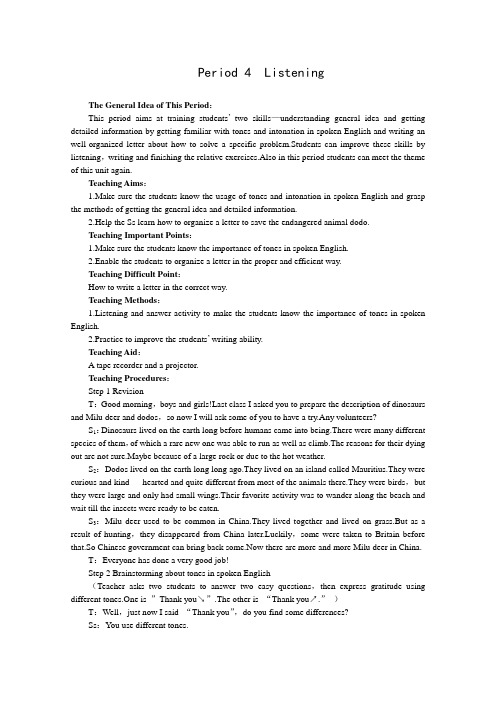
Period 4 ListeningThe General Idea of This Period:This period aims at training students’two skills—understanding general idea and getting detailed information by getting familiar with tones and intonation in spoken English and writing an well-organized letter about how to solve a specific problem.Students can improve these skills by listening,writing and finishing the relative exercises.Also in this period students can meet the theme of this unit again.Teaching Aims:1.Make sure the students know the usage of tones and intonation in spoken English and grasp the methods of getting the general idea and detailed information.2.Help the Ss learn how to organize a letter to save the endangered animal dodo.Teaching Important Points:1.Make sure the students know the importance of tones in spoken English.2.Enable the students to organize a letter in the proper and efficient way.Teaching Difficult Point:How to write a letter in the correct way.Teaching Methods:1.Listening-and-answer activity to make the students know the importance of tones in spoken English.2.Practice to improve the students’ writing ability.Teaching Aid:A tape recorder and a projector.Teaching Procedures:Step 1 RevisionT:Good morning,boys and girls!Last class I asked you to prepare the description of dinosaurs and Milu deer and dodos,so now I will ask some of you to have a try.Any volunteers?S1:Dinosaurs lived on the earth long before humans came into being.There were many different species of them,of which a rare new one was able to run as well as climb.The reasons for their dying out are not sure.Maybe because of a large rock or due to the hot weather.S2:Dodos lived on the earth long long ago.They lived on an island called Mauritius.They were curious and kind hearted and quite different from most of the animals there.They were birds,but they were large and only had small wings.Their favorite activity was to wander along the beach and wait till the insects were ready to be eaten.S3:Milu deer used to be common in China.They lived together and lived on grass.But as a result of hunting,they disappeared from China later.Luckily,some were taken to Britain before that.So Chinese government can bring back some.Now there are more and more Milu deer in China.T:Everyone has done a very good job!Step 2 Brainstorming about tones in spoken English(Teacher asks two students to answer two easy questions,then express gratitude using different tones.One is ”Thank you↘”.The other is “Thank you↗.”)T:Well,just now I said “Thank you”,do you find some differences?Ss:You use different tones.T:Good.In the first one,the falling tone shows that I am very grateful.But in the second one,the rising tone means that is what the S should do and I was not really grateful.T:In spoken English,tones are used to express different feelings.To understand how the speaker is feeling,listen for four main things:the volume of the languagea rising or falling tonestress on certain wordspauses in the sentencesStep 3 Listening for general ideaT:OK,now we are going to listen to the story about another animal named dodo.Please have a look at the picture on P31.What does it look like?Ss:It looks like a duck.It’s very large.T:What about its wings?Are they very large too?Ss:No,its wings are very small.T:Can it fly high in the sky easily?S1:I don’t think it can easily fly high in the sky.T:Do you agree with her?Ss:Yes.T:So what might be its problem?S2:It can only walk on land.And when there is an animal attacking it,it can’t escape.T:You might be right.Let’s listen and see.As for the first time,you don’t have to understand every word.You can ignore what you don’t understand and concentrate on what you can understand.Now please open your books and turn to Page 30 to go through the Ex.2 and try to predict what might happen to dodo.(Two minutes later)T:What happened to dodo?Ss:It disappeared.T:Right.Check the answers to Ex.2 and get some Ss to tell the mistakes in the other choices.Step 4 Listen for detailed informationGet the Ss to listen to the tape again and fill in the blanks.Once upon a time I lived on the earth too.I was called “dodo”.My home was an ______ called Mauritius.I was ______ and ______ and quite ______from most of the animals there.I liked to make friends with the other animals and never ______.I have no enemies.We were birds too,but we were large and only had small ______.My favorite activity was to ______ along the beach and wait till the insects were ready to be eaten.Get the Ss to discuss the answers in pairs and then check the answers to blanks (Suggested answers:island,curious,kind-hearted,different,quarreled,wings,wander)and Ex.1 (CDBC).Getthem to tell the reasons for their choices.Step 5 Further PracticeT:After we learn the story about the dodo,we shall again know the importance of protecting our environment.In fact to protect our earth is to protect ourselves.Next we shall listen to one more story about human beings and their environment.Please turn to P62.Listen for the first time and get the general idea.(After listening for the first time)T:What is the main idea of the story,do you think?S1:It’s about how a farmer improved his empty land and made his farm more beautiful.T:Good job.Get the Ss to listen for the second time and try to finish Ex.1 on P62.(After the Ss’ listening for the second time)Get them to discuss the answers in groups of four and then check the answers together.At last listen to the tape for the last time to check the answers.Listen for the third time and finish Ex.1.Step 6 Summary and HomeworkT:In this class,we have learned the importance of tones in spoken English,how to find out the general idea and the detailed information.After class,you should go on listening to more materials and try all efforts to make your ears sharp.That’s all for this class.Class is over.Homework:Surf the internet to find more information about the endangered animals in China and think of some ways to protect them.Step 7 The Design of the Writing on the BlackboardUnit 4 Wildlife protectionPeriod 4Listen for the general ideaListen for detailed informationtones,intonation,stress etc.dodo (large body,small wings)Step 8 Record after Teaching。
人教版高中英语必修二unit4学习优质教案

人教版高中英语必修二unit4学习优质教案一、教学内容本节课,我们将深入探讨人教版高中英语必修二Unit 4"Wildlife Protection"内容。
具体涉及Chapter 3Reading and Thinking部分,重点学习课文"The Story of the Giant Pandas"。
本文讲述中国大熊猫保护历程,旨在提高学生对野生动物保护意识。
二、教学目标1. 让学生掌握课文中重点词汇和短语,如"endangered species"、"wildlife protection"等;2. 培养学生阅读理解能力,理解课文内容,掌握文章结构;3. 提高学生思辨能力,使其能够就野生动物保护问题展开讨论;4. 培养学生跨文化交际意识,解并尊重不同文化背景下野生动物保护观念。
三、教学难点与重点1. 教学难点:理解并运用课文中重点词汇和短语,掌握文章结构,进行思辨性讨论。
2. 教学重点:提高学生阅读理解能力,培养其野生动物保护意识。
四、教具与学具准备1. 教具:多媒体教学设备、PPT、黑板、粉笔;2. 学具:教材、笔记本、彩色笔。
五、教学过程1. 导入:通过展示一组关于野生动物图片,引发学生对野生动物保护兴趣,进而导入本课主题。
2. 阅读前:让学生预测课文内容,激发阅读兴趣。
3. 阅读中:让学生快速浏览课文,回答问题,理解文章大意。
接着,详细讲解课文,分析文章结构,学习重点词汇和短语。
a. Why are giant pandas endangered?b. What measures have been taken to protect giant pandas?c. How can we contribute to wildlife protection?5. 例题讲解:针对本节课重点词汇和短语,设计例题进行讲解。
- 1、下载文档前请自行甄别文档内容的完整性,平台不提供额外的编辑、内容补充、找答案等附加服务。
- 2、"仅部分预览"的文档,不可在线预览部分如存在完整性等问题,可反馈申请退款(可完整预览的文档不适用该条件!)。
- 3、如文档侵犯您的权益,请联系客服反馈,我们会尽快为您处理(人工客服工作时间:9:00-18:30)。
必修二Unit 4教案一.复习旧知灭绝动物大海牛于1768年灭绝;渡渡鸟于1681年灭绝;恐鸟于1800年左右灭绝;大海雀于1844年灭绝;开普(好望角)狮于1865年灭绝(生活最南端、最大的狮子亚种);阿特拉斯棕熊于1870年灭绝(唯一产于非洲的棕熊和熊类);南极狼于1875年灭绝(生活在地球最南端的犬科);美国缅因洲海鼬于1880年灭绝;……于20世纪90年代灭绝(区域性灭绝);亚欧水貂于1997年左右灭绝.据世界《红皮书》统计,20世纪有110个种和亚种的哺乳动物以及139种和亚种的鸟类在地球上消失了。
目前,世界上已有593种鸟、400多种兽、209种两栖爬行动物和20000多种高等植物濒于灭绝。
米长天蛾人(Mothman)是一种不明的奇异生物,又名黑天使,惟一的克星是上帝之网。
可以隐形,此时只有同伴相互可见,雌体较雄体强壮,每一具雌体都是雄体的启蒙者。
二.新课讲解1.As a result / as a result of区别as a result 作为状语来用,强调结果。
后面一般用逗号隔开。
as a result of + 名词(短语)/代词强调原因,意义相当于because of .Eg: He worked hard at his study. As a result, he passed the exam easily.As a result of his hard work, he passed the exam easily.2. Die outdie from 一般指除了疾病、情感、饥寒以外的原因而造成的死亡,指死于外因die of(内部因素)情感、疾病、饥寒死因die for为……而死,为……而献身,表示因事业或目的而死。
die out ①种类灭绝Elephants would die out soon if men were allowed to shoot.②逐渐消失Many old customs are dying out.③渐渐变小The fire died out in the enddie away 光、声音慢慢消失,风停下来He died from smoking/drinking……He hid behind the door until the footsteps had died away3. Reservevt. 1). 储备,保存;保留[(+for)]These seats are reserved for special guests. 这些座位是为特别的来宾保留的。
We will reserve the money; we may need it later. 我们将把这笔钱存起来,也许以后用得着。
2). 预约,预订They have reserved rooms at a hotel. 他们已预订了旅馆房间。
I have reserved a table at the restaurant. 我已在饭店预订了一桌菜。
n.1). 储备(物);储备金; [C][U][(+of)]The old man kept a large reserve of firewood for cold weather.这位老人贮存了大量的柴薪以备天冷时用。
2). 保留地;保护区;禁猎区[C] 3). 储备选手,候补[C]4.In peace / at war 处于战争状态in peace: 安静地,和平地,和睦地例句与用法:Please let me do my work in peace.请让我安静地工作。
rest In peace:指死后灵魂安息May his soul rest in peace! 愿他的灵魂祥和地安息!5.In danger 事物本身对别人没威胁,但事物本身出危险的环境下dangerous事物本身对别人有威胁,别人说这个事物是危险的e.g. We cannot find the kid. It's dark, she must be in danger now.小孩找不到了,天黑了,她处境危险。
It is dangerous to walk too near the edge of a cliff.太走近悬崖边是危险的。
danger表示“危险”,是不可数名词,表示“危险的人或物”,是可数名词。
短语out of danger脱离危险on the danger list 病入膏肓endangered 濒临危险的6.Apply 动词“申请”“应用”apply sth to sth /sb是指把某物应用在某物/人上但是注意,因为这里的to是做介词用,所以如果要在to后面用动词,必须用动词的ing形式。
apply for是申请的意思,是申请某职位,某证明,某奖学金等等apply for visa申请签证apply for a position申请职位I want to apply for the scholarship of this school.we can apply this new technology to our new product.例题Look the nurse _____ some m edicine_____ the wound in the soldier’s leg.A. applies ; atB. applied ; toC. is applying ; withD. is applying ; to答案D Look指“看啊”,表示正在发生,apply sth. to sth/sb. 固定用法,是指把某物应用在某物/人上7. Suggest1)suggest doing sth.They suggested waiting until the proper time. 他们建议(我们)等到恰当的时机才行动.2)suggest thatShe suggested that the class meeting (should) not be held on Saturday.她建议班会不要在星期六举行.3)suggest sth. to sb. 有"提出"的意思He suggested a different plan to his boss. 他向老板提出了一个不同的计划.Xiao Wang suggested a way to solve the problem. 小王提出了一个解决这个问题的办法.4)有"暗示、表明"的意思.其主语往往是事物,而不是人. 接名词或动名词作宾语.The simple house suggested a modest income. 这座简朴的房子表明(房主的)收入并不高.Her pale face suggested bad health. 她脸色苍白,看来身体不好.The thought of summer suggests swimming. 一想到夏天就使人们联想到游泳.8. Protect…..from……1)、prevent sb from doing sth与stop sb from doing sth 均为“阻止某人做某事”用法相同,在主动语态中from可以省略,被动语态中不行。
2)、keep sb from doing sth中的from无论在主动语态中还是在被动语态中都不能省略。
你可以这样想一想,如果没有了from就变成了keep sb doing sth了,意思就反过来了。
3)、protect……from/again ……表示“保护……不受……侵袭,挡住,防御”。
from后接能带来伤害或损害之物。
Eg:1:You should protect the children from catching cold. 你应该防备孩子们受凉。
9. Containcontain: have or hold sth within itselfinclude: have sb/sth as part of a whole这样看来,contain,include的区别:都有“包含”的意思,“include主要强调被包含的东西本身是其一部分,而contain则强调包含不属于本身的其他东西在里面。
”例如:The parcel contained a dictionary. 那包裹里装的是一本字典。
e.g. The health club includes a gym, swimming pool , and locker room.The pill contains vitamins. 这药丸中含有多种维生素。
10. Affect词汇辨析affect, effect, influence:1)affect常用作动词,意思是“对……有影响”或“给……带来变化”。
例如:Does second hand smoke affect the health of all of us?2)effect在大多数情况下都被用作名词,意为“结果” “效果”;“作用”;“影响”:to affect sth.=to have an effect on sth.例如:The drug did not affect the disease, and it had several adverse (不利的,反对的)side effects.一个简便的原则就是如果你需要一个动词的话,十之八九选用affect,如果需要一个名词,则通常使用effect.3)influence指通过行动、榜样等对他人产生潜移默化的影响或作用,注重“影响”的结果。
记忆形似词:effect n.影响;effort n.努力infect vt.[医] 传染, 感染。
主要是指传染(病毒什么的),一般不用在好事情上。
考点提要in effect = in fact 实际上;take effect = come into force 实施,生效;例题Reading on bed ——A——our eyes.A. has a bad effect on B .take a bad effect on C.has a bad effect to D. has a bad affect on have an effect on对...有影响11. Pay attention topay attention to doing...注意,关心,留心。
Draw/catch attention to... 使人们关注... ;e.g. The article was intended to draw attention to the situation in Cambodia.这篇文章旨在呼吁人们关注柬埔寨局势。
